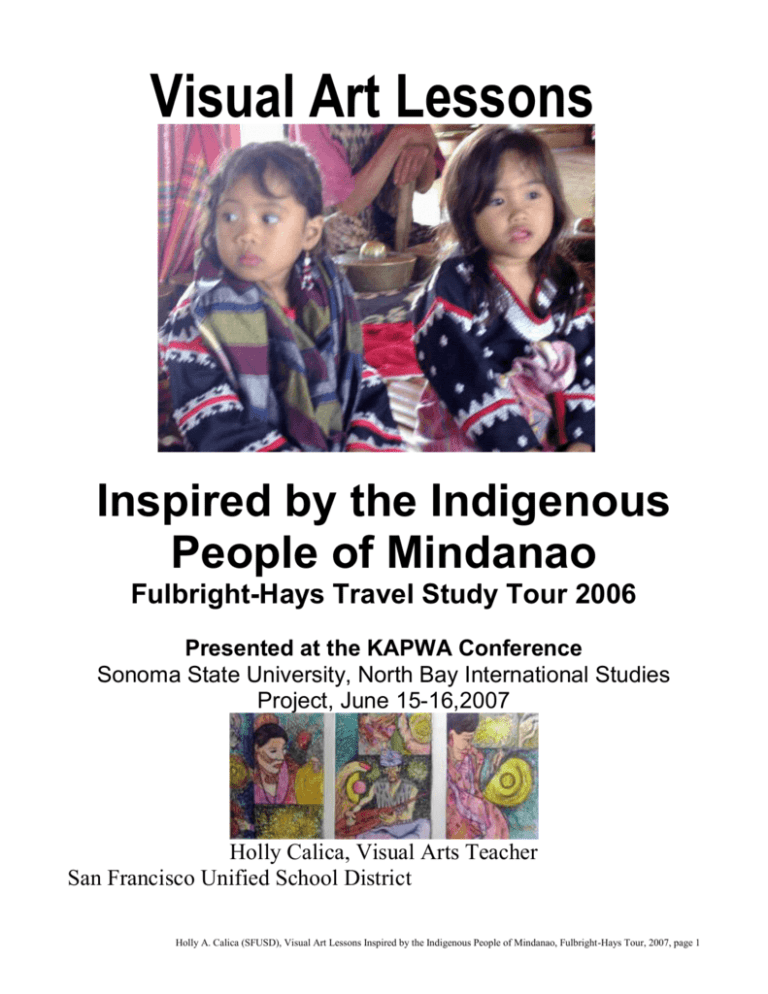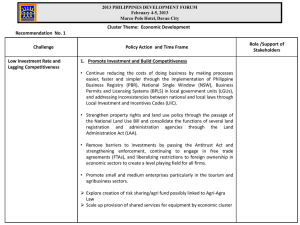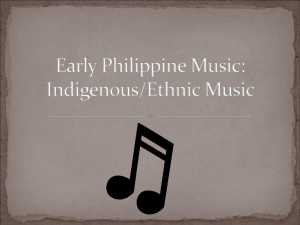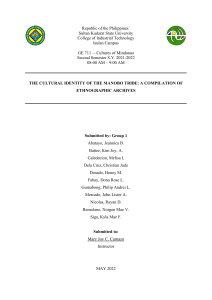Mindanao Indigenous Art Lessons
advertisement

Visual Art Lessons Inspired by the Indigenous People of Mindanao Fulbright-Hays Travel Study Tour 2006 Presented at the KAPWA Conference Sonoma State University, North Bay International Studies Project, June 15-16,2007 Holly Calica, Visual Arts Teacher San Francisco Unified School District Holly A. Calica (SFUSD), Visual Art Lessons Inspired by the Indigenous People of Mindanao, Fulbright-Hays Tour, 2007, page 1 Background information on indigenous people gathered by 4th grade students from Leonard R. Flynn Elementary School and shared in small group discussions. Websites include: http://www.seasite.niu.edu/Tagalog/Cynthia/Mindanao/ethnolingusticgroups.htm#Maranao http://class.csueastbay.edu/anthropologymuseum/virtmus/Philippines/Peoples/Blaan.htm http://www.byahilo.com/?p=192 http://www.humanity.org/voices/folklore/ I also brought in art work created by artisans, shared photographs taken during my Fulbright tour in 2006 and had students listen to kulintang music. This was done after students had started project, as I wanted them to use their own imaginations when they created their illustrations. Sample T’boli photos: The following pages are a compilation of the information gathered by the children. Holly A. Calica (SFUSD), Visual Art Lessons Inspired by the Indigenous People of Mindanao, Fulbright-Hays Tour, 2007, page 2 The Mandaya Tribe of Davao: The Mandaya tribeswomen traditionally makes their hand-woven cloth called dagmay out of abaca fibers. These cloth are then usually made into clothes, bags, wallets, table runners or placemats. Ata Manobo Tribe: Datu Quirino Gabao, 65 years old, is the leader of the Tigwa Manobo settlement Kibongkog, together with his brother, Datu Esteban Gabao. His headdress (tangkulu), decorated with bristles of a wild boar, is especially typical for the minority people of that area down to Davao (Tigwa, Matigsalug, Ata and Langilan Manobo as well as Bagobo).Kibongkog, San Fernando, Bukidnon. August 9, 1993, 11 a.m. . Kadayawan Festival: The Kadayawan Festival is one of the most colorful festivals in the country. It is a thanksgiving celebration by the people of Davao every month of August. Holly A. Calica (SFUSD), Visual Art Lessons Inspired by the Indigenous People of Mindanao, Fulbright-Hays Tour, 2007, page 3 Blaan Tribe: The Blaan traditionally live in the hills near the Davao gulf in territory abutting that of the Bagobo, and in the Davao and Cotabato watersheds; more recently they have moved into the coastal area. Their culture has been changing very rapidly. Houses are scattered about the swidden fields, generally within sight of each other, and neighborhoods are ruled by hereditary datus. The lebe is the Blaan equivalent of the Bagobo magani. Bagobo: The Bagobo is a tribe that traces its origin from the people who brought Hinduism to Mindanao during the Sri Vijayan and Majapahit invasion. When the people inter-married with the locals, they formed a new society and came up with the name Bagobo. The word “Bagobo” is derived from the root word “bago,” which means “new” or “recent” while the “obo” suffix means “grow” in the tribe’s dialect. The Bagobos have a light brown complexion. Their hair is brown or brownish black, ranging from wavy to curly. The men have an average height of five feet and three inches, while the women’s height average is five feet. Although their faces are wide, their cheekbones are not too prominent. Their eyes are dark and widely set, while the eye slits are slanting. The males and females deliberately shave their eyebrows to a thin line. The root of their nose is low, while the ridge is broad. Their lips are full and their chins are round. Holly A. Calica (SFUSD), Visual Art Lessons Inspired by the Indigenous People of Mindanao, Fulbright-Hays Tour, 2007, page 4 T'Boli Tribe: Like other hill people, the T'Boli subsist on hunting, fishing and cultivation. The rivers, lakes and marshes of the region have always been the source of the fish caught by using fishing rods, spews, nets and other traps. Mudfish, catfish, fresh water shrimp and snails are common food items. Ducks are also raised along the lake's shores. Manobo Tribes: For hundreds of years these tribes roamed the valleys and mountains, doing slash-and-burn agriculture and having little or no contact with the outside world. From birth they have heard the oral traditions, myths and ballads, and have practiced the ways that made them distinctly Manobo - different from the lowland Filipino and neighboring tribal groups. Perhaps the strongest of their beliefs is that a person cannto leave the traditional spirits and ways and still be a true Manobo. Manobo" is the hispanicized form of "Manuvu," which, of course, means "people." The Manobo appear to be a remnant of the very first Austronesian invasion from Taiwan, predating peoples like the Ifugao of Luzon. The general orientation is now predominantly upland, as they were chased from the valleys by invading Visayans and Spaniards. But the Manobo have an adaptation to virtually every ecological niche, from rugged highland to coast, and are found from Sarangani Island to Agusan del Sur, the Davao provinces, Bukidnon, and North and South Cotabato. Kinship is figured bilaterally, and nuclear households are kin-grouped into widely dispersed communities usually situated on ridges high above mountain drainages. Some communities have long houses. Leadership is achieved by a skilled and socially powerful datu who creates alliances in many ways, including marriage. Several area datus would be organized under a higher datu, united in turn under the Sultanate with a Rajah Muda. This structure is gradually giving way to the westernized scheme of provincial government and local councilmen, which places more emphasis on the young and educated. The distinctive ethnic costumes have mostly given way to commercial clothing, with ethnic materials being sold commercially as antiques. Holly A. Calica (SFUSD), Visual Art Lessons Inspired by the Indigenous People of Mindanao, Fulbright-Hays Tour, 2007, page 5 Kalagan & Tagakaolo Tribes: The Kalagan live on the island of Mindanao in the southern Philippines. They are located in an area between the interior uplands and the western coast of the Davao Gulf. The Kalagan are thought to be one of various groups of lowland Filipinos who came to the islands from Asia's southwestern mainland several thousand years ago. Their lifestyle and culture are very similar to that of the Magindanaw. With the arrival of Islam in the 1500's, the Kalagan split into two separate groups—the Tagakaulu Kalagan and the Tagakaolo Kalagan. The Tagakaulu Kalagan speak Tagakaolo, which is closely related to a number of other languages spoken in the region. While some of the Tagakaulu Kalagan receive wages for labor, others work as farmers. Maize is the major crop grown and is harvested two or three times a year. The coastal Kalagan are also fishermen; others work as laborers on plantations. Maranao People: The Maranao are famed for their sophisticated weaving and wood and metal craft. Maranao means "People of the Lake," after their traditional territory in the area surrounding Lake Lanao in the Bukidnon-Lanao Plateau, which is some 2,200 feet above sea level. They are one of the largest Islamic groups in the Philippines. Core areas as Marawi City, Lumba-a-bayabao, and Bayang. The Maranao are a splinter group of the Magindanao who took up Islam; all families trace their religious origin to Sharif Kabunsuan, who introduced the religion in the area. Communities are clustered around a mosque and a torogan, a royal house belonging to the leading economic household in the area. The Maranao are widely distributed and play an important role in market trade. Besides exotic textiles, metalwork, and woodcraft, the torogan building is perhaps the most spectacular example of Filipino secular architecture. The awang, or dugout boat used in Lake Lanao, is possibly the most unique and ornate of dugouts. Maranao textiles, which indicate the status of the wearer, are known for their very ornate designs and colors. The design motifs which form the basis for the okil are highly systematized. NOtable among them are the sari-manok and naga, abstract animate forms of the cock, and dragon or snake, respectively. They also utilize a unique tube skirt, the malong. Holly A. Calica (SFUSD), Visual Art Lessons Inspired by the Indigenous People of Mindanao, Fulbright-Hays Tour, 2007, page 6 Maranao Art Okir or okkil refers to the ranfe of folk motifs, usually of plants and geometric forms, that are prominent in Maranao art work. The oldest proof of okir's flowering is the torogan, the ancestral home of the highest titleholder in a Maranao village. The torongan is a symbol of rank abd prestige and is reserved for important celebrations and political events. It stands out architecturally in the community because if its panolong - a carved beam that protrudes in the front of the house and is adorned with okir motif. Aside from plan and vegetable forms, the panalong has come to be dominated by the nafa or sepent motif. The malong, woven Maranao cloth, also bears various okir designs.In fact, the geometric and plant designs on the vertical strips of the malong indicate the wearer's village of origin. Brass and metal works, from the fuctional betel-nut boxes to musical instruments, always carry these designs as well. A more distinctive variation is the sarimanok, a chickenlike figure that carries a fish in its beak. Images from Traveler's Companion: Philippines Sources: Insight Guides: Philippines and Filway's Philippine Almanac Centennial Edition Holly A. Calica (SFUSD), Visual Art Lessons Inspired by the Indigenous People of Mindanao, Fulbright-Hays Tour, 2007, page 7 Bukidnon People: The 50,000 Bukidnon of East Lanao are a tribe of fiercely independent highland dwellers. Yakan: Yakan is another unique cultural group of Sulu living on Basilan Island south of Zamboanga. They are gentle people of partial Polynesian origin, with mixed Muslim and animalist beliefs. They are the most superb textile weavers of the southern archipelago. On backstrap looms they turn fine cotton and silks into remarkable geometric work of art. Holly A. Calica (SFUSD), Visual Art Lessons Inspired by the Indigenous People of Mindanao, Fulbright-Hays Tour, 2007, page 8







